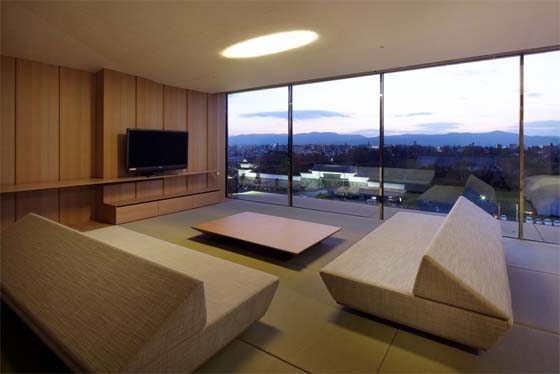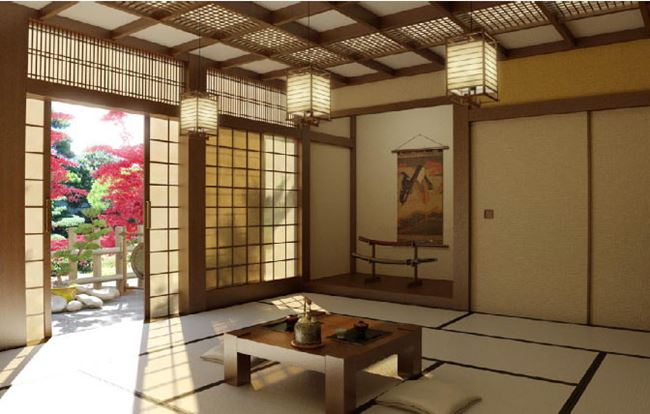Japanese style, also known as Zen or minimalistic style, is characterized by its simplicity, natural elements, and focus on balance and harmony. This style is often associated with tranquility and has a calming effect on the space and its occupants. If you’re interested in creating a Japanese-inspired living room, there are a few key elements to consider.
First, consider the color palette for your space. Japanese style often incorporates neutral colors like white, beige, and grey, as well as natural elements like wood and stone. You can add pops of color with accents like green plants or colorful artwork, but be sure to keep it minimal and balanced.
Next, focus on the layout and furniture of your living room. In Japanese style, it’s important to create a sense of openness and flow in the space. Choose furniture with clean lines and minimal ornamentation, and consider using sliding doors or screens to separate the space into different areas without blocking the flow of movement.
Incorporating natural elements like wood, stone, and plants is also an important part of Japanese style. Bamboo or wooden furniture and accessories, as well as stone accents like lanterns or water features, can bring a sense of grounding and connection to nature to your living room. Adding plants, especially those with lush green foliage, can also bring life and energy to the space.
Texture is also an important element to consider in Japanese style. Choose textiles like rice paper, silk, or linen for a soft, natural feel. You can also add texture through the use of materials like wood, stone, or bamboo.
In Japanese culture, the concept of “wabi-sabi” is an important aspect of design. Wabi-sabi is the acceptance of imperfection and the beauty that can be found in the imperfect. In your living room, you can incorporate wabi-sabi by choosing furniture and accessories that are slightly imperfect or have a sense of history, like antique or distressed pieces.
Lighting is another important element to consider in a Japanese-inspired living room. Soft, indirect lighting is often used to create a calm and peaceful atmosphere. You can use floor lamps or table lamps with rice paper or fabric shades to achieve this effect.
Finally, consider the use of negative space in your living room. In Japanese style, it’s important to allow for empty or unoccupied space in the design. This helps to create a sense of balance and allows the eye to rest.
By incorporating these elements into your living room design, you can create a serene and elegant space that reflects the principles of Japanese style. Remember to keep it simple, natural, and balanced, and you’ll have a living room that promotes tranquility and relaxation.
Finally, consider the use of negative space in your living room. In Japanese style, it’s important to allow for empty or unoccupied space in the design. This helps to create a sense of balance and allows the eye to rest.
By incorporating these elements into your living room design, you can create a serene and elegant space that reflects the principles of Japanese style. Remember to keep it simple, natural, and balanced, and you’ll have a living room that promotes tranquility and relaxation.
Finally, consider the use of negative space in your living room. In Japanese style, it’s important to allow for empty or unoccupied space in the design. This helps to create a sense of balance and allows the eye to rest.
By incorporating these elements into your living room design, you can create a serene and elegant space that reflects the principles of Japanese style. Remember to keep it simple, natural, and balanced, and you’ll have a living room that promotes tranquility and relaxation.
Creating a Japanese-inspired living room can be a beautiful and serene addition to your home. Here are some tips and ideas for creating a space that is elegant and reflective of Japanese culture:
- Choose minimal and natural decor: Japanese design is known for its simplicity and focus on natural materials. Use natural wood and stone elements, and choose furnishings with clean lines and minimal ornamentation.
- Incorporate elements of nature: Bring the outdoors in by adding plants and flowers to the space. Bamboo, orchids, and cherry blossoms are popular choices in Japanese decor.
- Use neutral colors: Japanese design often incorporates neutral colors such as white, beige, and gray. These colors can help create a peaceful and serene atmosphere.
- Add texture through fabrics: Incorporate texture through the use of traditional Japanese fabrics such as silk and cotton. These can be used for window treatments, throw pillows, and other decorative elements.
- Incorporate traditional Japanese elements: Consider adding traditional Japanese elements such as shoji screens, tatami mats, and sliding doors to the space. These can help to create a cohesive and authentic Japanese-inspired look.
By following these tips and ideas, you can create a beautiful and serene Japanese-inspired living room that is both elegant and reflective of the culture’s rich traditions.






